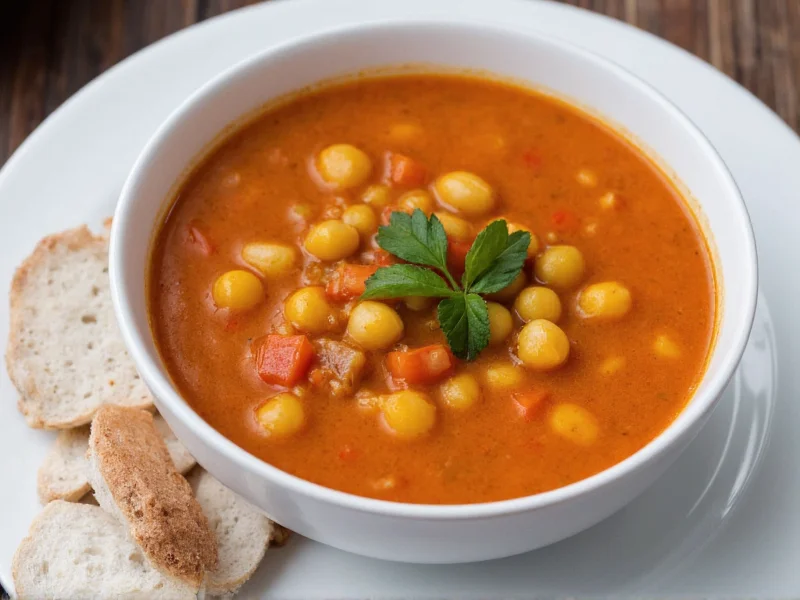What Exactly Is Garbanzo Soup?
Garbanzo soup centers around Cicer arietinum, commonly known as chickpeas or garbanzo beans. Despite the naming difference, garbanzo beans and chickpeas are identical legumes—“garbanzo” comes from Spanish while “chickpea” derives from the Latin “cicer.” This soup has deep roots in Spanish, Italian, and North African cuisines, where it’s traditionally prepared with simple pantry staples. Unlike many canned soups, homemade garbanzo soup delivers superior flavor complexity and nutritional value without preservatives.
Nutritional Powerhouse: Why Garbanzo Soup Deserves a Regular Spot in Your Meal Plan
One 1.5-cup serving of homemade garbanzo soup provides remarkable nutritional benefits that processed alternatives can’t match. The combination of soluble and insoluble fiber supports digestive health while helping maintain steady blood glucose levels. Let’s examine the specific nutritional profile:
| Nutrient | Per Serving (1.5 cups) | Daily Value % |
|---|---|---|
| Calories | 285 | 14% |
| Protein | 15g | 30% |
| Fiber | 12g | 43% |
| Iron | 4.5mg | 25% |
| Folate | 280mcg | 70% |
Regular consumption of this high-fiber, plant-based soup correlates with reduced risk of cardiovascular disease according to research published in the American Journal of Clinical Nutrition. The magnesium and potassium content further supports healthy blood pressure regulation. For vegetarians and vegans, garbanzo soup serves as an excellent protein source that’s more digestible than many other legumes when properly prepared.
Essential Ingredients for Authentic Garbanzo Soup
The magic of exceptional garbanzo soup lies in ingredient quality and proper technique. While canned chickpeas offer convenience, dried beans provide superior texture and flavor absorption when cooked from scratch. Here’s what you need for the foundational recipe:
- Dried garbanzo beans (1 cup, soaked overnight) - or 2 cans (15oz each), drained
- Aromatic base: 1 large onion, 3 carrots, 2 celery stalks, all finely diced
- Flavor builders: 4 garlic cloves, 2 bay leaves, 1 tsp cumin, 1 tsp smoked paprika
- Liquid components: 6 cups vegetable broth, 2 tbsp tomato paste
- Finishing touches: Fresh lemon juice, chopped parsley, extra virgin olive oil
For those seeking an easy garbanzo bean soup recipe without overnight soaking, canned beans work well but require careful rinsing to remove excess sodium. When using dried beans, add 1/4 teaspoon baking soda to the soaking water to improve digestibility—a traditional Spanish technique that breaks down complex sugars responsible for gas production.
Step-by-Step Preparation Guide
Follow these professional kitchen techniques for perfectly textured garbanzo soup every time:
- Bean preparation: If using dried beans, soak 8 hours minimum. Drain and rinse thoroughly.
- Soffritto foundation: In a large pot, sauté onions, carrots, and celery in olive oil over medium heat until translucent (8-10 minutes). Add garlic and spices, cooking 1 minute until fragrant.
- Liquid integration: Stir in tomato paste, then gradually add broth while scraping browned bits from pot bottom.
- Simmering process: Add soaked beans (with soaking water discarded), bay leaves, and a pinch of salt. Bring to boil, then reduce heat to low. Cover and simmer 45-60 minutes until beans are tender but not mushy.
- Texture refinement: For creamier texture, blend 1/3 of the soup then return to pot. Alternatively, mash some beans against the pot side with a wooden spoon.
- Final seasoning: Remove bay leaves. Stir in lemon juice and adjust salt. Drizzle with quality olive oil before serving.
Delicious Variations to Explore
Once you master the traditional Spanish garbanzo soup, experiment with these regional adaptations:
- Moroccan-inspired: Add 1/2 teaspoon each of cinnamon, ginger, and turmeric with a handful of dried apricots during final 15 minutes of cooking
- Italian zuppa di ceci: Stir in 2 cups chopped kale and 1/4 cup pesto just before serving
- Spicy Mexican version: Include diced jalapeño, 1 cup corn, and 1/2 cup chopped cilantro with a squeeze of lime
- Creamy roasted garlic: Blend soup with 6 cloves roasted garlic for a restaurant-quality creamy garbanzo soup
Serving Suggestions and Storage Tips
Garbanzo soup shines when served with complementary elements that enhance its earthy flavor profile. Pair with crusty whole-grain bread for dipping, or serve over cooked quinoa for added protein. A sprinkle of nutritional yeast provides a cheesy flavor boost for dairy-free diets. Leftovers maintain quality exceptionally well—store in airtight containers for up to 5 days in the refrigerator or freeze for 3 months. When reheating, add a splash of broth to restore ideal consistency.
Troubleshooting Common Garbanzo Soup Issues
Even experienced cooks encounter challenges with legume-based soups. Here’s how to solve frequent problems:
- Tough beans: If using dried beans, ensure they’re fresh (less than 1 year old) and avoid adding acidic ingredients like tomatoes until beans are fully tender
- Excessive foam: Skim foam during initial boiling phase—this contains compounds that cause digestive discomfort
- Bland flavor: Build layers of taste by sautéing spices in oil before adding liquids, and finish with bright acid like lemon juice
- Too thick: Gradually add warm broth or water until desired consistency is reached











 浙公网安备
33010002000092号
浙公网安备
33010002000092号 浙B2-20120091-4
浙B2-20120091-4